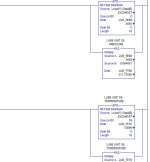dalporto
Lifetime Supporting Member
Hi all.
I'm working on a rehab and I'm trying to figure stuff out.
See screenshot at the bottom.
Local:5:I.Data[6] in BTD instruction is a data point coming from a DeviceNet 32 bits DINT. The instruction is reading half of it (length 16), so basically it looks this block is switching register order, but I may be very wrong with my understanding. Anyway that's not really the point here.
So I got a 832246557 value going to a 4983 value.
Then they put a multiplier to scale the value to the ENG units. I think it's kPa here but that's not important for now.
What I'd like to know is if I can find out the actual 0-100% scaling from that and how I could calculate it from that information, if it's even possible.
Not sure if this is the proportional of an INT value using 2 147 483 647, which would possibly give a 735 kPa transmitter, a little over 100 PSIG.
If you have any insight on what is actually happening there, please share.

I'm working on a rehab and I'm trying to figure stuff out.
See screenshot at the bottom.
Local:5:I.Data[6] in BTD instruction is a data point coming from a DeviceNet 32 bits DINT. The instruction is reading half of it (length 16), so basically it looks this block is switching register order, but I may be very wrong with my understanding. Anyway that's not really the point here.
So I got a 832246557 value going to a 4983 value.
Then they put a multiplier to scale the value to the ENG units. I think it's kPa here but that's not important for now.
What I'd like to know is if I can find out the actual 0-100% scaling from that and how I could calculate it from that information, if it's even possible.
Not sure if this is the proportional of an INT value using 2 147 483 647, which would possibly give a 735 kPa transmitter, a little over 100 PSIG.
If you have any insight on what is actually happening there, please share.





